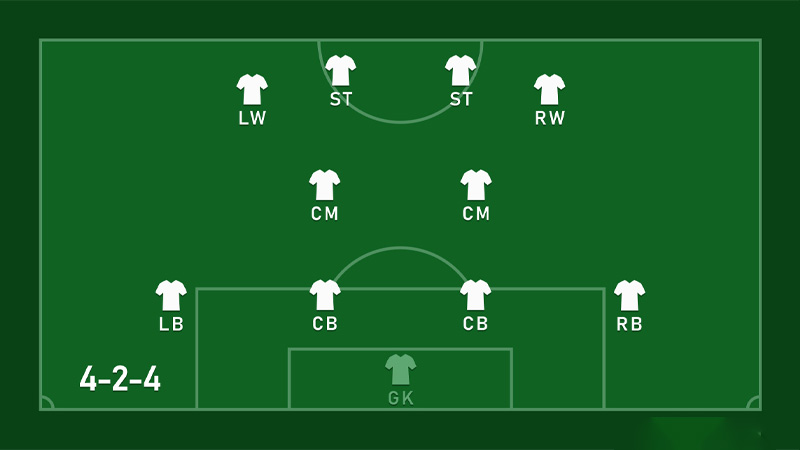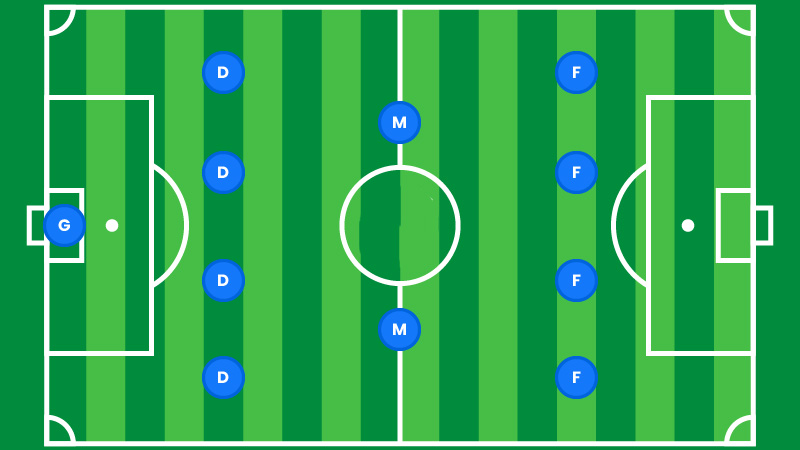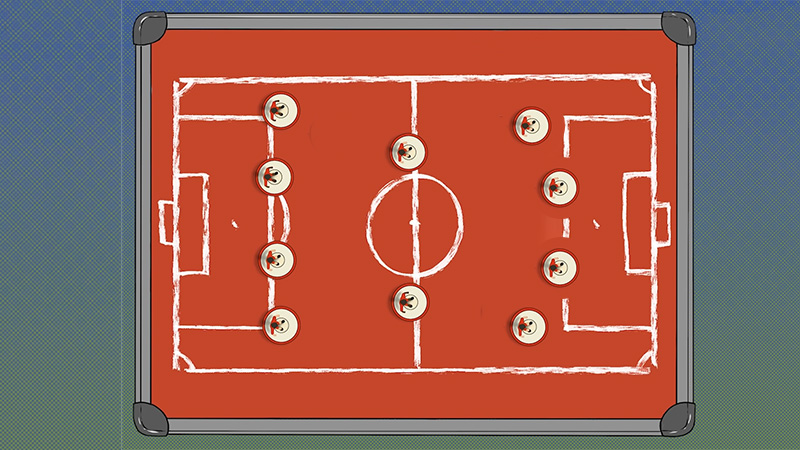In the dynamic world of soccer tactics, coaches are constantly searching for innovative ways to gain an advantage over their opponents. One such formation that has garnered attention in recent years is the 4-2-4 formation.
This attacking-minded setup places a heavy emphasis on offensive play, aiming to overwhelm the opposition with a relentless wave of attacking options.
In this article, we will delve into the intricacies of the 4-2-4 soccer formation, exploring its origins, key characteristics, player roles, and tactical considerations.
The 4-2-4 formation relies on quick transitions from defense to attack. The team must be adept at winning the ball back and launching swift counter-attacks to catch the opposition off guard.
By understanding the nuances of this formation, coaches and fans alike can appreciate the beauty and effectiveness of its attacking philosophy.
Evaluation of the 4-2-4 Soccer Formation
The 4-2-4 formation originated in Brazil during the 1950s and 1960s. It was popularized by the Brazilian national team, which featured legendary players such as Pelé and Garrincha.
The formation was a response to the traditional 4-3-3 system, aiming to maximize attacking potential by deploying four forwards upfront.
During this era, Brazil revolutionized the game with its attacking style of play, known as “samba football.” The 4-2-4 formation was a key component of this approach, allowing Brazil to overwhelm its opponents with a relentless attacking force.
The success of the Brazilian national team in the 4-2-4 formation inspired other teams and coaches around the world to experiment with this attacking approach. However, as the game evolved, defensive strategies became more sophisticated, and teams began to prioritize defensive stability.
As a result, the 4-2-4 formation gradually fell out of favor at the highest levels of the game. Coaches started to adopt more balanced formations, such as the 4-4-2 or 4-3-3, which provided better defensive cover and midfield control.
However, the principles and attacking mindset of the 4-2-4 formation continue to influence modern football. Some teams still utilize variations of the formation, adapting it to suit their playing style and personnel.
How Do You Play a 4-2-4 Soccer Formation?

Source: footballizer
The 4-2-4 soccer formation is an attacking formation that focuses on maintaining a strong presence in the opponent’s half. Here’s a breakdown of how to play this formation:
Goalkeeper (GK)
The goalkeeper remains in the goal and performs their usual duties, such as stopping shots and distributing the ball.
Defenders (4)
The four defenders consist of two center-backs (CB) and two full-backs (FB). The center-backs provide stability and cover the central areas, while the full-backs provide width and support in both defense and attack.
Midfielders (2)
The two midfielders play in a central position, just in front of the defenders. They are responsible for controlling the midfield, breaking up the opponent’s play, and distributing the ball to the attacking players.
Forwards (4)
The four forwards consist of two wide forwards (WF) and two center forwards (CF). The wide forwards operate on the flanks, stretching the opponent’s defense and providing crosses into the box. The center forwards focus on scoring goals and creating opportunities in and around the penalty area.
Playing Style
- Attacking mindset: The 4-2-4 formation is inherently offensive, so the team should prioritize attacking play and aim to score goals.
- Quick transitions: With four forwards, the team can quickly transition from defense to attack. The midfielders should look to release the ball to the forwards as soon as possible.
- Wide play: The full-backs and wide forwards should work together to create width and stretch the opponent’s defense. This allows for more space in the middle for the center forwards to exploit.
- High press: To disrupt the opponent’s build-up play, the team can employ a high-pressing strategy. This involves putting pressure on the opponent’s defenders and midfielders to force mistakes and win the ball back quickly.
Key Considerations
- Defensive vulnerability: With only two midfielders, the team may be susceptible to counter-attacks and opposition midfield overload. The defenders should communicate effectively and provide cover when necessary.
- Fitness and stamina: The 4-2-4 formation requires high levels of fitness from the players, especially the forwards who need to constantly press and make runs.
- Team coordination: Effective communication and understanding between players are crucial for the success of this formation. The players should be aware of their roles and responsibilities and work together as a cohesive unit.
Strengths of the 4-2-4 Soccer Formation

Source: quora
The 4-2-4 soccer formation offers several strengths that can benefit a team. Here are some of the key strengths of the 4-2-4 formation:
Attacking Prowess
The 4-2-4 formation is designed to prioritize attacking play. With four forwards, the team can put significant pressure on the opponent’s defense and create numerous goal-scoring opportunities.
This formation allows for a high number of attacking players to be present in the opponent’s half, increasing the chances of scoring goals.
Offensive Versatility
The 4-2-4 formation provides flexibility in attack. The wide forwards can stretch the defense and create space for the center forwards to exploit. The full-backs can provide width and support in both defense and attack, adding an extra dimension to the team’s attacking options.
Quick Transitions
With four forwards positioned high up the pitch, the team can quickly transition from defense to attack. This allows for fast and direct counter-attacks, catching the opposition off guard and creating scoring opportunities.
Overloading the Opponent’s Defense
The 4-2-4 formation can overload the opponent’s defense, particularly in wide areas. The wide forwards and full-backs can combine to create numerical advantages and overload the opponent’s full-backs, making it difficult for the opposition to defend effectively.
Pressing and Defensive Intensity
The 4-2-4 formation allows for an aggressive pressing style. With four forwards leading the press, the team can put significant pressure on the opponent’s defenders and midfielders, forcing mistakes and turnovers in dangerous areas.
This high-intensity defensive approach can disrupt the opponent’s build-up play and create scoring opportunities.
Psychological Advantage
The attacking nature of the 4-2-4 formation can put the opposition on the back foot and create a psychological advantage. The constant threat of multiple attacking players can unsettle the opponent’s defense and force them to adopt a more defensive mindset, potentially opening up space for the team to exploit.
It’s important to note that while the 4-2-4 formation offers several strengths, it also has its limitations and requires a well-drilled and cohesive team to maximize its potential.
Coaches should consider the team’s strengths, weaknesses, and the opposition’s style of play when deciding on the most suitable formation.
Weaknesses of the 4-2-4 Soccer Formation

Source: rookieroad
While the 4-2-4 soccer formation has its strengths, it also has some inherent weaknesses that coaches and teams should be aware of. Here are a few key weaknesses of the 4-2-4 formation:
Defensive Vulnerability
The 4-2-4 formation can leave the team exposed defensively, especially in the midfield area. With only two midfielders, there may be a lack of cover and protection for the defense.
This can make the team susceptible to counter-attacks and opposition midfield overload, as there are fewer players to disrupt the opponent’s play in the middle of the pitch.
Lack of Midfield Control
With only two midfielders, the team may struggle to control the midfield against opponents who play with three or more midfielders. This can lead to difficulties in maintaining possession and controlling the tempo of the game.
The team may also face challenges in transitioning from defense to attack smoothly, as there may be fewer passing options in midfield.
Fatigue and Stamina
The 4-2-4 formation requires high levels of fitness and stamina from the players, particularly the forwards who need to constantly press, make runs, and contribute to both attacking and defensive phases of play.
Sustaining this level of intensity throughout the game can be physically demanding and may lead to fatigue as the match progresses.
Lack of Width in Defense
While the 4-2-4 formation provides width in attack through the full-backs and wide forwards, it can leave the team vulnerable to attacks down the flanks. The full-backs may be caught out of position when the opposition counter-attacks, leaving space for wingers or overlapping full-backs to exploit.
Limited Central Midfield Creativity
With only two central midfielders, the team may face challenges in terms of creativity and playmaking in the center of the pitch.
The midfielders may have to prioritize defensive duties over attacking contributions, which can limit the team’s ability to create scoring opportunities through the middle.
Lack of Numerical Advantage in the Midfield
The 4-2-4 formation often results in a numerical disadvantage in midfield, especially against teams that play with three central midfielders.
This can make it difficult to win and retain possession in midfield battles, as the opposition may have an extra player to dominate the central areas.
It’s important for coaches to consider these weaknesses and find ways to mitigate them through tactical adjustments, player roles, and effective communication and coordination among the team members. Flexibility and adaptability are key in addressing the limitations of any formation.
FAQs
Can the 4-2-4 formation be used defensively?
While the 4-2-4 formation is primarily an attacking formation, it can be adapted to incorporate defensive strategies. The team can focus on maintaining a compact shape, with the midfielders and forwards working together to press and disrupt the opponent’s play.
How can the 4-2-4 formation be adjusted to counter a strong opponent?
Against a strong opponent, adjustments may be needed to address the potential weaknesses of the 4-2-4 formation. One option is to drop one of the forwards into a deeper position, creating a 4-3-3 or 4-4-2 shape when defending.
What types of players are best suited for the 4-2-4 formation?
The 4-2-4 formation requires players who are comfortable in attacking roles and possess good technical skills. The forwards should have strong goal-scoring abilities and be able to make intelligent runs to create scoring opportunities.
Can the 4-2-4 formation be used in youth soccer?
The 4-2-4 formation can be used in youth soccer, but it may require adjustments based on the age and skill level of the players. Younger players may struggle with the physical demands of the formation, so it’s important to consider their fitness and stamina levels.
Are there any famous teams that have used the 4-2-4 formation?
The 4-2-4 formation gained popularity in the 1950s and 1960s, with the Brazilian national team being one of the most famous teams to utilize this formation. The Brazilian team, led by coach Vicente Feola, won the 1958 FIFA World Cup using the 4-2-4 formation.
Bottom Line
The 4-2-4 soccer formation offers a captivating and aggressive approach to the game of soccer. With its focus on overwhelming the opposition with a relentless attacking force, this formation has the potential to create an exhilarating spectacle for fans.
However, it also demands a high level of tactical understanding, player versatility, and disciplined defensive work.
As the game continues to evolve, the 4-2-4 formation remains an intriguing option for teams seeking to dominate matches through offensive prowess. By harnessing the strengths of this formation and adapting it to suit their team’s style, coaches can unlock a world of attacking possibilities.
Whether it becomes a mainstay or a tactical surprise, the 4-2-4 formation will continue to captivate the imagination of soccer enthusiasts worldwide.







